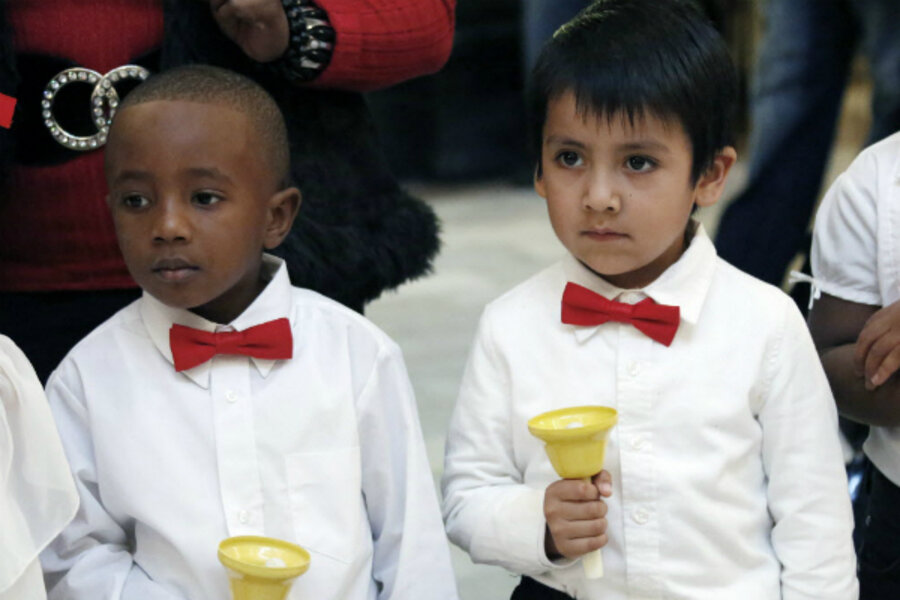Pre-K programs take biggest state funding hit ever
Loading...
The 2011-12 school year was not a good one for pre-K funding, for enrollment, or for quality, according to a major new survey.
States' funding overall dropped by more than half a billion dollars – its biggest one-year drop ever. After a decade of growth, enrollment in state-funded pre-K programs stalled. State funding per child fell by more than $400; counting previous drops, state per-pupil spending decreased by more than $1,100 over the prior decade. And quality also slipped in a number of state programs.
“What was surprising was not that the recession hurt [pre-K programs], but that it hurt so much,” says Steven Barnett, director of the National Institute for Early Education Research (NIEER) at Rutgers University, which released the annual “State of Preschool” 2012 yearbook Monday. “The one indicator that increased was inequality, because some states have continued to move ahead, while other states are moving backwards.”
The report comes at a time when early childhood education is getting more attention than ever, at least at the federal level. In his State of the Union message, President Obama highlighted the importance of quality pre-K and urged a major expansion.
“Every dollar we invest in high-quality early education can save more than seven dollars later on – by boosting graduation rates, reducing teen pregnancy, even reducing violent crime,” Mr. Obama said in his speech. In his budget, he requested $75 billion over 10 years to help states dramatically expand preschool options for low-income children.
“If ever there was a report that makes the case for the need for President Obama's preschool-for-all proposal, this report is it,” said Education Secretary Arne Duncan, speaking at a release of the NIEER report on Monday.
Not all the news is bad on the preschool front, and state funding and enrollment vary dramatically from state to state. Ten states, for instance, have no public preschool program at all, while eight enroll more than half of all 4-year-olds in public pre-K programs. Washington, D.C., has the highest percentage, with more than 90 percent of 4-year-olds and nearly 70 percent of 3-year-olds enrolled, and Florida, Oklahoma, Vermont, Wisconsin, and West Virginia all served more than 60 percent of 4-year-olds in state-funded pre-K during the 2011-12 school year. Eleven states, meanwhile, have programs but served fewer than 10 percent of 4-year-olds.
The lack of enrollment growth for that school year, according to the report, was almost entirely due to 16 states that reduced their enrollment from the previous year – including four that reduced it by more than 10 percent.
And enrollment, cautions Dr. Barnett, is not the whole picture. Research makes clear that the benefits from preschool are only seen in high-quality programs, he says, and both the reduction in funding and the loss of “quality benchmarks” – things like comprehensive standards, training and degree requirements for teachers, and site visits – are troubling to him.
Particularly notable, he says, is the fact that five states stopped conducting site visits to monitor program quality, which he sees as a shortsighted decision.
“The first thing that gets cut is state capacity to monitor quality,” says Barnett. “That’s a recipe for seeing that the rest of the money is not going to be well spent…. The focus has to be on quality.”
Barnett cites Oklahoma and West Virginia as models of states that not only serve a relatively high percentage of children, but that also keep their quality standards high, meeting nearly all of the 10 benchmarks the report tracks.
Still, the biggest bright spot Barnett sees lies not in the state-funding picture, but in the promise of things to come if even some version of Obama’s plan is funded.
In particular, he notes, the fact that Obama has proposed a 10-year state-federal partnership with matching funds would help states during the time they need it most, as they recover from the effects of the recession.
“Some of these states have a deep hole to climb out of,” Barnett says. Seventy-five billion dollars over 10 years “could get states to where they need to be.”
But mostly, Barnett is glad to see universal – or at least expanded – preschool a major part of the national conversation, more people aware of its benefits, as well as the cost to America if it continues to lag behind other nations in providing it.
“I think this is the most important moment for preschool in the 30 years I’ve been studying it, because the president has put it on the national agenda,” he says. “If America is going to seize the future, this is the moment for preschool.”








